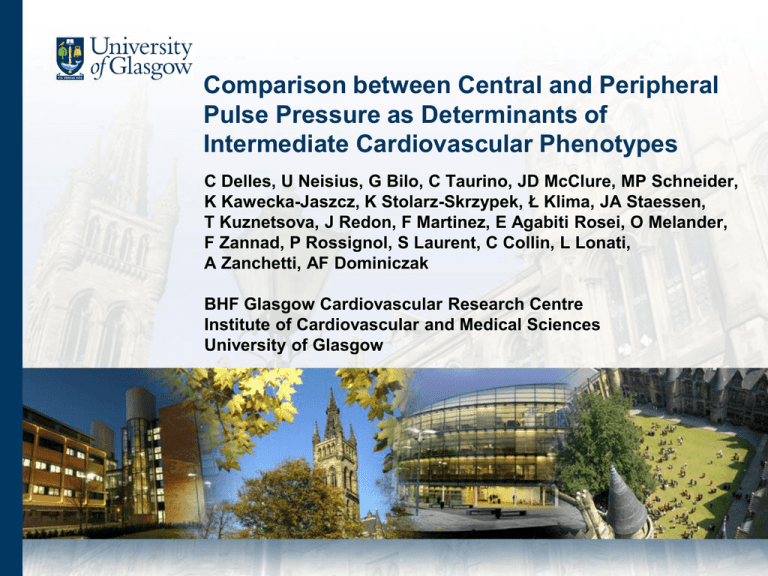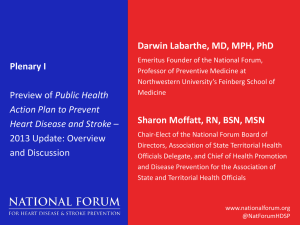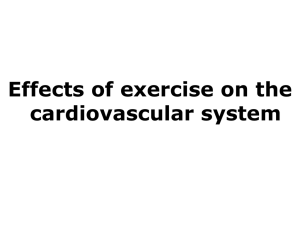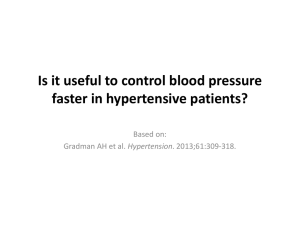
Comparison between Central and Peripheral
Pulse Pressure as Determinants of
Intermediate Cardiovascular Phenotypes
C Delles, U Neisius, G Bilo, C Taurino, JD McClure, MP Schneider,
K Kawecka-Jaszcz, K Stolarz-Skrzypek, Ł Klima, JA Staessen,
T Kuznetsova, J Redon, F Martinez, E Agabiti Rosei, O Melander,
F Zannad, P Rossignol, S Laurent, C Collin, L Lonati,
A Zanchetti, AF Dominiczak
BHF Glasgow Cardiovascular Research Centre
Institute of Cardiovascular and Medical Sciences
University of Glasgow
Blood Pressure
DeterminesContinuum
Cardiovascular Risk
Cardiovascular
Prospective Studies Collaboration. Lancet 2002
Pulse Pressure
Refines Cardiovascular
Risk
Cardiovascular
Continuum
Franklin SS et al. Circulation 1999
Pulse Pressure
Refines Cardiovascular
Risk
Cardiovascular
Continuum
Franklin SS et al. Circulation 2001
Central BP
Causes Central
Artery Damage
Cardiovascular
Continuum
Hypertension 2007; 50: 154-160
Question
Cardiovascular
Continuum
Is central blood pressure a better
predictor of cardiovascular risk
than peripheral blood pressure
in young to middle-aged people?
Question
Cardiovascular
Continuum
Is central pulse pressure a better
predictor of cardiovascular risk
than peripheral pulse pressure
in young to middle-aged people?
v
v
v
v
Question
Cardiovascular
Continuum
Is central pulse pressure a better
predictor of intermediate CV phenotypes
than peripheral pulse pressure
in young to middle-aged people?
v
v
v
v
InGenious HyperCare
Cardiovascular
Continuum
30
23
10
22
11
12
24
16 15
13 1417
26-27 25
8 9
29
19
18 21
20
7 1-3
4
6
5
31
Index Patient
•
•
•
•
Hypertension diagnosed < 50 years
Caucasian
Age 18-60
Index patient on treatment with ≥ 2 drugs or
SBP ≥ 160
• DBP ≥ 95 on two different occasions if
untreated
• At least three 1st degree relatives of whom at
least one should be affected (< 50 years ) and
at least one from a different generation
Examples of Possible Family Structures
affected
unaffected
index patient
Patients
Cardiovascular
Continuum
Age, years
Sex, male/female
Height, cm
Weight, kg
BMI, kg/m²
Sitting pSBP, mmHg
Sitting pDBP, mmHg
Sitting Heart rate, /min
Coronary heart disease, %
Creatinine, μmol/L
eGFR, mL/min
Diabetes mellitus, %
Supine pSBP, mmHg
Supine pDBP, mmHg
Supine cSBP, mmHg
Supine cDBP, mmHg
Supine pPP, mmHg
Supine cPP, mmHg
C-IMT, mm
LVMI, g/m².7
PWV, m/s
ACR, mg/mmol
Hypertensive
n=331
51±15
156/175
168±9
79.6 [70.0;91.0]
27.7 [25.0;31.4]
141±16
85±10
69±12
4.4
78 [64;87]
89±21
10.0
135 [125;146]
81±11
123 [114;135]
82±11
54 [46;63]
42 [35;50]
0.62 [0.52;0.75]
41.6 [35.4;49.0]
8.12 [7.08;9.70]
0.74 [0.48;1.28]
Normotensive
n=204
39±16
85/119
168±9
70.9 [61.5;82.2]
24.9 [22.0;28.4]
128±14
78±9
71±10
2.0
72 [62; 83]
99±25
3.0
126 [117;135]
76±9
113 [102;124]
77±10
49 [43;57]
34 [29;43]
0.55 [0.48;0.65]
35.4 [30.5;41.5]
7.00 [6.10;7.88]
0.69 [0.39;1.17]
P-value
<0.001
0.026
ns
<0.001
<0.001
<0.001
<0.001
ns
0.02
0.01
<0.001
<0.001
<0.001
<0.001
<0.001
<0.001
<0.001
<0.001
<0.001
<0.001
<0.001
ns
Methods
Cardiovascular
Continuum
•
•
•
•
•
•
Blood pressure (Omron)
Pulse wave analysis (mostly SphygmoCor)
Pulse wave velocity (mostly SphygmoCor)
Carotid intima-media thickness
Echocardiography
Urinary albumin:creatinine ratio
Pulse PressureContinuum
and Age
Cardiovascular
ns
ns
ns
cPP/pPP
ns
ns
ns
Hypertensives
Normotensives
Decade
Univariate Analysis
Cardiovascular
Continuum
log(intima-media thickness)
log(pulse wave velocity)
Central Pulse Pressure
A
Peripheral Pulse Pressure
B
r = 0.471
r = 0.372
P < 0.001
P < 0.001
C
D
r = 0.426
P < 0.001
r = 0.235
P < 0.001
log(intim
Univariate Analysis
Cardiovascular
Continuum
r = 0.426
P < 0.001
Central Pulse Pressure
r = 0.235
P < 0.001
Peripheral Pulse Pressure
F
log(LVMI)
E
r = 0.189
P < 0.001
r = 0.385
P < 0.001
H
log(ACR)
G
r = 0.236
P < 0.001
r = 0.226
P < 0.001
Age and Intermediate
Cardiovascular
Phenotypes
Cardiovascular
Continuum
Age, years
Age, years
Multivariate Analysis
Cardiovascular
Continuum
Central
β
Peripheral
β
P-value
P-value
log(PWV)
R2adj
0.399
0.413
Hypertension, (yes/no)
0.112
0.003
0.086
0.020
Heart Rate, bpm
0.128
0.001
0.098
0.009
Age, yrs
0.460
<0.001
0.515
<0.001
MAP, mmHg
0.089
0.044
0.111
0.006
log(PP)
0.226
<0.001
0.220
<0.001
Multivariate Analysis
Cardiovascular
Continuum
Central
β
Peripheral
β
P-value
P-value
log(C-IMT)
R2adj
0.429
0.428
Age, yrs
0.598
<0.001
0.633
<0.001
log(PP)
0.097
0.020
0.076
0.037
log(LVMI)
R2adj
0.181
0.170
Age, yrs
0.318
<0.001
0.386
<0.001
log(PP)
0.160
0.002
0.085
0.051
Summary
• Central pulse pressure is more strongly correlated with
intermediate cardiovascular phenotypes than peripheral
pulse pressure.
• In a young to middle-aged cohort of normotensive and
well-controlled hypertensive subjects, age is the major
determinant of intermediate cardiovascular phenotypes.
• When adjusted for relevant cofactors including age,
models containing either cPP or pPP predict
intermediate cardiovascular phenotypes equally well.
• Limitations: cross-sectional design, case-control design
and family structure.
Perspective and Clinical Relevance
• Assessment of central haemodynamic parameters
provides an integrated view on blood pressure and other
determinants of cardiovascular phenotypes.
• Our data do not support the notion that central blood
pressure is a superior determinant of risk than
peripheral blood pressure if age is taken into account.
• Large and prospective studies on the use of central
haemodynamic parameters in clinical practice are still
required – and under way.
Results by Study
Centre
Cardiovascular
Continuum
Results by Gender
Cardiovascular
Continuum
age (years)
cPP (mmHg)
pPP (mmHg)
PWV (dm/s)
C-IMT (10-2 mm)
LVMI (g/m2.7)4
200
150
100
50
0
Male
Female
gender
Blood Pressure
and Cardiovascular
Cardiovascular
Continuum Risk
Prospective Studies Collaboration. Lancet 2002
Central BP and Antihypertensive Treatment
Atenolol based
Amlodipine based
Williams B et al. Circulation 2006
Local Pulse Pressure and Large Arteries
Circulation 1999: 100:1387-1393







